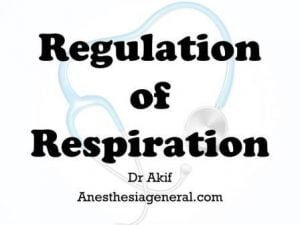The Regulation of Respiration is mediated by various centers in the brain. They are:
• Pneumotaxic centre in upper pons.
• Apneustic centre in lower pons.
• Ventral group of neurons in medulla (expiratory group).
• Dorsal group of neurons in medulla (inspiratory group).
Normally pneumotaxic centre has inhibitory effect on apneustic centre which otherwise produces apneustic breathing or inspiratory spasm.
 Normally the Regulation of Respiration is done by expiratory and inspiratory neurons of medulla.
Normally the Regulation of Respiration is done by expiratory and inspiratory neurons of medulla.
During inspiration stretch receptors in lung parenchyma, which are supplied by vagus get stimulated leading to inhibition of inspiratory group of neurons and hence stopping the inspiration.
Expiration is normally passive and expiratory group of neurons comes into play only during active expiration.
These central respiratory centers are most sensitive to changes in CSF pH which in turn is influenced by pCO2 (partial pressure of carbon dioxide in blood).
Increase inpCO2 stimulates the respiration while
Decrease in pCO2 inhibits respiration.
Other factors effecting respiratory centers are:
• Body temperature
• Hypoxia
• Exercise
• Pain
• Hypothalamus
• Cortex
Peripheral chemoreceptors effect on Regulation of Respiration:
These are present in carotid body and aortic arch. Carotid body receptors are very sensitive to hypoxia.
Anesthetic gases and Regulation of Respiration:
All inhalational agents (except nitrous oxide and minimum with ether) have depressant effect on ventilatory response to increased CO2 and hypoxia.
For more answers to more questions like this Ask a Doctor.
